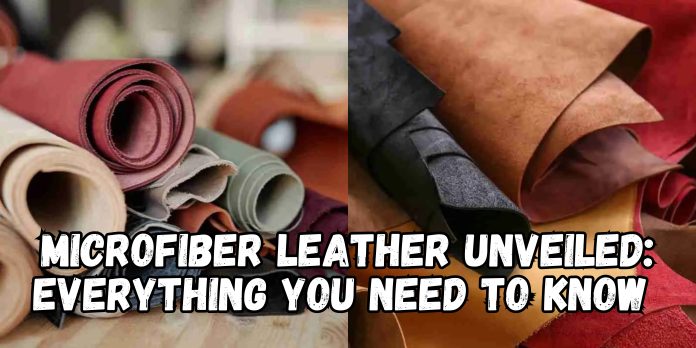Microfiber Leather Unveiled
Microfiber leather has quickly become one of the newest synthetic materials, emerging as an eco-friendly and cost-efficient alternative to genuine and faux leather in fashion, furniture, and automotive applications. Boasting cutting-edge technology combined with durability and aesthetic appeal, microfiber leather presents an appealing solution in various fields such as fashion, furniture, and automotive applications. But just what exactly is microfiber leather and what sets it apart from other materials? In this blog, we’ll go into every aspect of its composition to advantages, and uses in more depth.
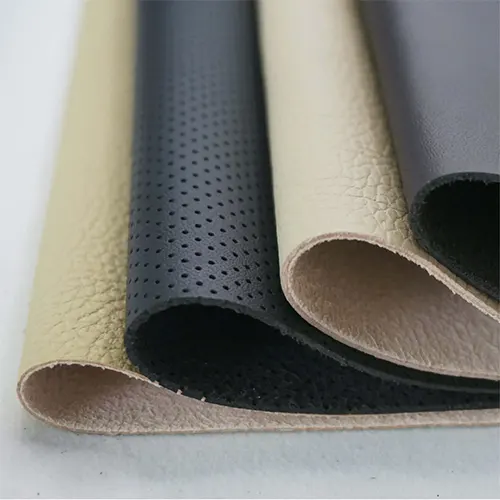
1. What Is Microfiber Leather?
Microfiber leather is an ultra-high-quality synthetic leather material fabricated using microfiber fabrics made up of ultrafine polyester fibers and polyurethane (PU) resins. “Microfiber” refers to extremely fine fibers much finer than silk hair or natural leather fibers used to produce this lightweight yet soft and water-repellant material that replicates its look while also being lightweight.
Microfiber leather has become the go-to faux leather of choice due to its ability to overcome some of the constraints inherent in traditional PVC or PU synthetic leathers.
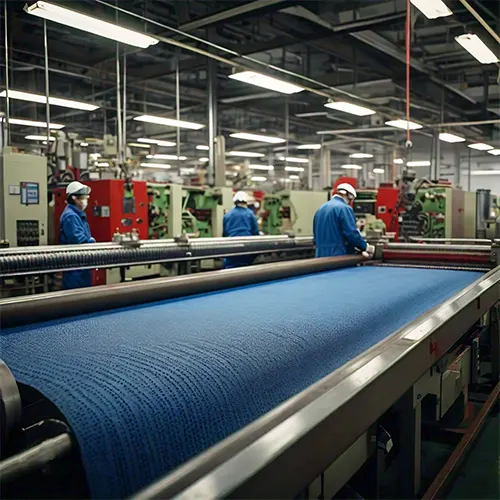
2. How Is Microfiber Leather Made?
Producing microfiber leather involves multiple stages to achieve its realistic look and feel, including texture, durability, and aesthetic qualities. Here is an overview of this process:
- Step 1: Creation of Microfibers: Ultrafine polyester filaments are spun and woven together into dense mats using intricate weave techniques, giving microfiber leather its strength and smoothness.
- Step 2: Coating with Polyurethane (PU): Once the microfiber base has been created, it is coated with a layer of polyurethane resin which imparts leather-like textures while offering water resistance and long-term durability.
- Step 3: Embossing: To give their material the look and texture of real leather grain, manufacturers emboss its surface with patterns that create an authentic leather appearance.
- Step 4: Dyeing and Finishing: Once finished, the material is dyed and treated with finishing agents to enhance its aesthetic, feel, and performance characteristics.
This synthetic material mimics leather perfectly while performing excellently across a range of applications.
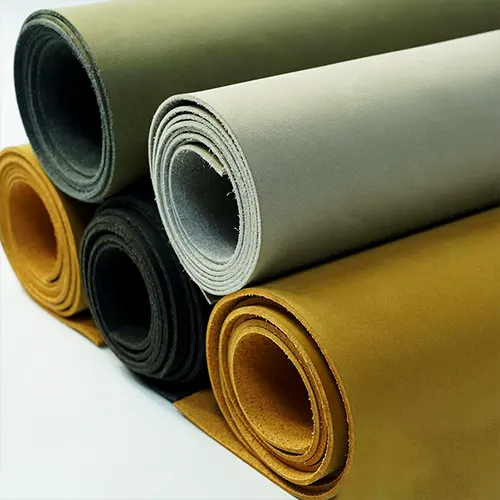
3. Key Benefits of Microfiber Leather
Microfiber leather boasts numerous advantages over both genuine leather and other synthetic types, making it an attractive option for consumers, manufacturers, and designers. Here are a few key benefits:
a. Durability and Strength
Microfiber leather is highly resilient, often outshone by other synthetic leather options in terms of durability. Thanks to tightly woven microfibers that resist tears, abrasions, punctures, and tears without loss in shape or appearance from heavy use.
b. Lightweight and Breathable
Microfiber leather differs significantly from its faux-leather counterpart in that it is lightweight and breathable, providing greater comfort when worn or used for upholstery as it won’t trap heat or cause discomfort.
c. Water-Resistant and Stain-Resistant
Microfiber leather’s primary advantage lies in its resistance to water and stain damage, thanks to the polyurethane coating that repels moisture – this makes cleaning and maintaining this material simple, making it suitable for furniture, car interiors, or fashion items that must withstand everyday wear and tear.
d. Environmentally Friendly
Microfiber leather has long been seen as an eco-friendly alternative to genuine leather due to its production method requiring no animal hides and tanning processes that involve harmful tanneries. Furthermore, improvements in microfiber production mean some varieties use reduced energy usage and toxic chemical usage resulting in even greener manufacturing options for microfiber leather production.
e. Cost-Effective
Although genuine leather can be expensive due to the costs associated with animal farming, tanning, and craftsmanship processes, microfiber leather offers a more economical yet still high-quality alternative that combines quality aesthetics.
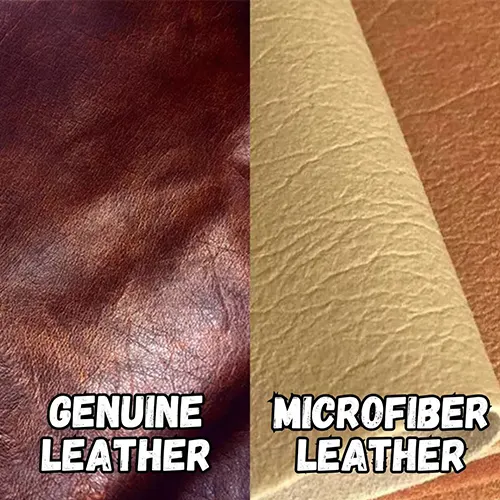
4. Microfiber Leather vs. Genuine Leather
Comparing microfiber leather and real leather requires considering several factors:
- Aesthetic Appeal: Microfiber leather’s goal is to closely resemble genuine leather, making it difficult for an untrained eye to distinguish the two at first glance. But while real leather develops an aged patina over time that gives it its distinct appearance, microfiber leather does not. This gives genuine leather the edge it needs when it comes to aesthetics whereas durable microfiber doesn’t.
- Maintenance: Genuine leather requires regular conditioning to avoid cracking and drying out, whereas microfiber leather requires no special oils or conditioners for upkeep.
- Ethical and Environmental Impact: Microfiber leather is a cruelty-free option that doesn’t involve animal products. Additionally, its production can be less harmful to the environment compared to traditional leather tanning, which often involves toxic chemicals.
- Price: Microfiber leather is generally more affordable than genuine leather, offering a similar look and feel at a lower cost.
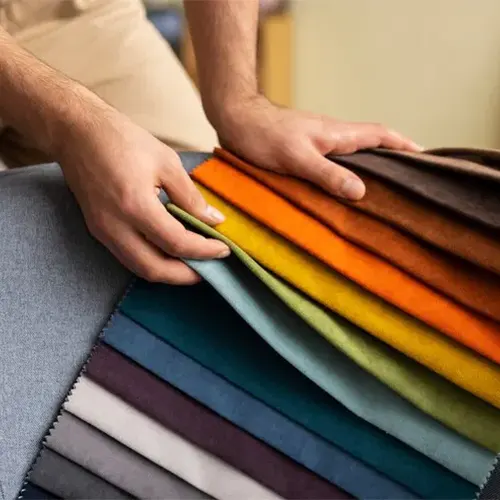
5. Common Uses of Microfiber Leather
Microfiber leather’s versatility has made it a go-to material in numerous industries. Some common applications of this versatile fabric include:
a. Fashion and Apparel
Microfiber leather is commonly found in jackets, shoes, bags, and belts made with microfibre material, making it the perfect fabric choice for daily wear. Thanks to its lightweight construction and durable nature it provides comfort with everyday use.
b. Furniture and Upholstery
Manufacturers widely utilize microfiber leather furniture upholstery in sofas and chairs. Due to its water-resistant properties and easy maintenance needs, microfiber leather makes it an attractive option for households with kids or pets.
c. Automotive Interiors
Microfiber leather has become increasingly popular as an affordable premium look without breaking the bank. Microfiber leather’s strength and wear resistance make it suitable for car seats and interiors, providing premium looks without real leather’s high price point.
d. Sports Equipment
Microfiber leather has become widely utilized for manufacturing sports equipment such as soccer balls, gloves, and shoes due to its durability in handling rough environments.
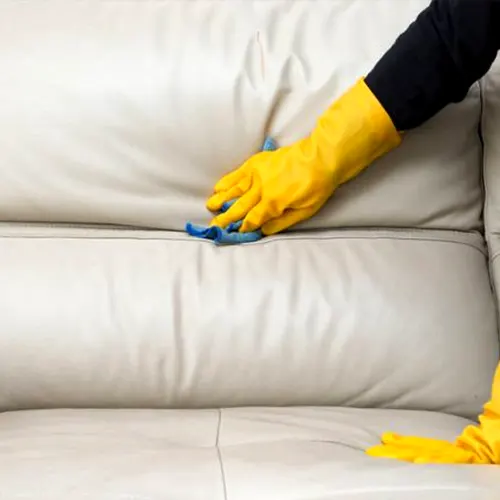
6. How to Care for Microfiber Leather
One of the greatest appeals of microfiber leather products lies in how easy they are to take care of, so here are a few key care guidelines you should abide by to keep them looking their best:
- Clean Spills Promptly: If something spills onto microfiber leather, use a damp cloth to quickly blot up any spilled liquid without rubbing as this could potentially harm its surface.
- Avoid Harsh Chemicals: Cleaning microfiber leather requires using mild soaps or cleaners designed specifically to treat synthetic materials since harsh chemicals could degrade its polyurethane coating and damage its structural integrity.
- Store Properly: Store microfiber leather items in a cool, dry location when not in use to avoid prolonged exposure to direct sunlight or heat, which could result in discoloration or cracking over time.
Conclusion
Microfiber leather has emerged as a prominent option for those searching for high-quality, eco-friendly alternatives to genuine leather in fashion, furniture design, or automotive interiors. From fashion runways and clothing showrooms to car interiors and automotive dashboards; microfiber leather provides the ideal blend of style, performance, and sustainability – and as technology improves it could become even more widely utilized across multiple industries.
Are You Searching for an Attainable and Sustainable Material to Create the Look and Feel of Leather Without Ethics and Maintenance Considerations? Microfiber Leather might just be what’s necessary.


